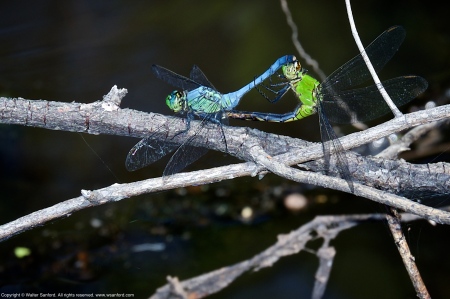Eureka! As a result of either persistence or perseveration, I succeeded in photographing a mating pair of Eastern Pondhawk dragonflies (Erythemis simplicicollis) while field-testing my new Fujifilm X-T1 digital camera and 55-200mm zoom lens (88-320mm, 35mm equivalent) at Huntley Meadows Park on 15 August 2014.
The pair is shown “in wheel.” All dragonflies and damselflies have a 10-segmented abdomen, numbered from front to back: male dragonfly secondary genitalia are located in segments two and three (2 and 3); female genitalia in segment eight (8). Therefore, the male dragonfly is on top; the female is on the bottom.
The male member of this mating pair is a young male. See “Related Resources,” shown below, for links to a three-part series of photoblog posts illustrating color change in male Eastern Pondhawk dragonflies as they mature.

Photo 1. ISO 200; 200mm (320mm, 35mm equivalent); -1 ev; f/8; 1/350s
Notice the fishing spider in the background of the next photo.

Photo 2. ISO 200; 200mm (320mm, 35mm equivalent); -1 ev; f/8; 1/180s
I have never seen a pair of mating Eastern Pondhawk dragonflies hook-up as long as this couple — the same pair perched at three locations! Perhaps young males are more virile than mature males.

Photo 3. ISO 200; 200mm (320mm, 35mm equivalent); -1 ev; f/8; 1/250s
Related Resources:
Editor’s Notes: The preceding photos were taken using Aperture Priority (f/8). The drive mode was set for continuous shooting (low-speed burst, ~3 fps). A small pop-up flash was connected to the camera and the flash mode was set for forced flash, but flash doesn’t fire in burst mode. The focus mode was set for single autofocus; it would have been better to use continuous autofocus.
If you look closely at the full-size versions of these photos, then you will notice the focus is a little soft. In order to shoot tack-sharp photos using a hand-held camera and 200mm lens (320mm, 35mm equivalent), I would prefer to use a combination of a shutter speed of at least 1/640s with fill flash: this configuration works with my Panasonic Lumix DMC-FZ150 superzoom digital camera (superseded by Panasonic Lumix DMC-FZ200 superzoom camera); it doesn’t work with my new Fujifilm X-T1. Mirror-less digital cameras still require a shutter in order to properly expose larger image sensors such as the APS-C sensor featured in the X-T1. Using the X-T1, flash will synchronize with the shutter at shutter speeds of 1/180s or slower. Needless to say, I need to learn to adapt/adjust to the wonderful world of flash sync speed. Hey Fuji HQ — if you’re reading this, then your engineers need to start working on an external flash unit that features a hi-speed sync mode like my Canon 580EX II Speedlite … STAT!
All of that being said, my credo for wildlife photography is: “Get a shot, any shot; refine the shot.” Although my camera set-up wasn’t ideal, I got the shot when there was an opportunity; regrettably there was no time to refine the shot. Better luck next time, right?
More Related Resources:
Copyright © 2014 Walter Sanford. All rights reserved.





















